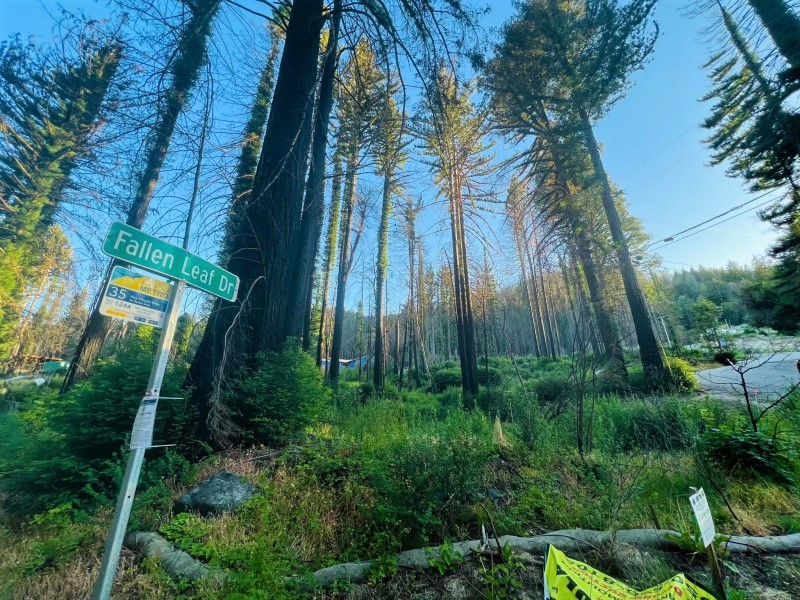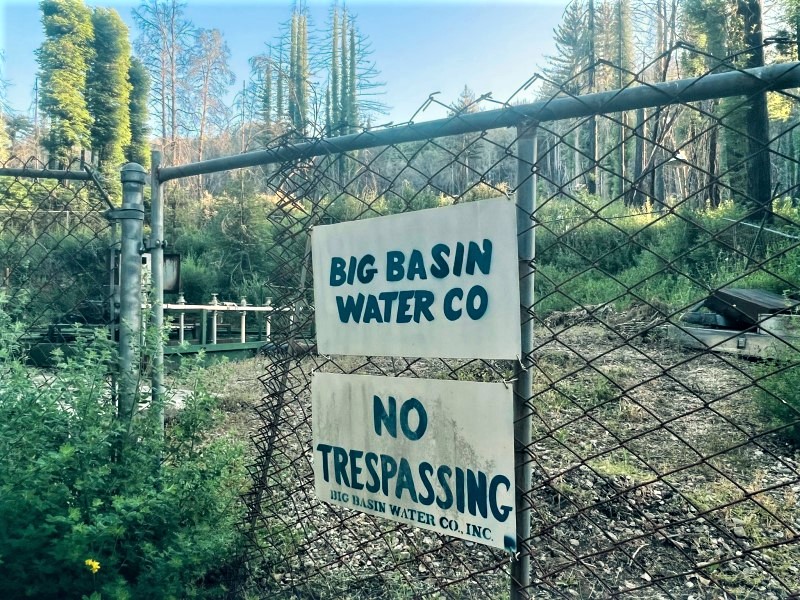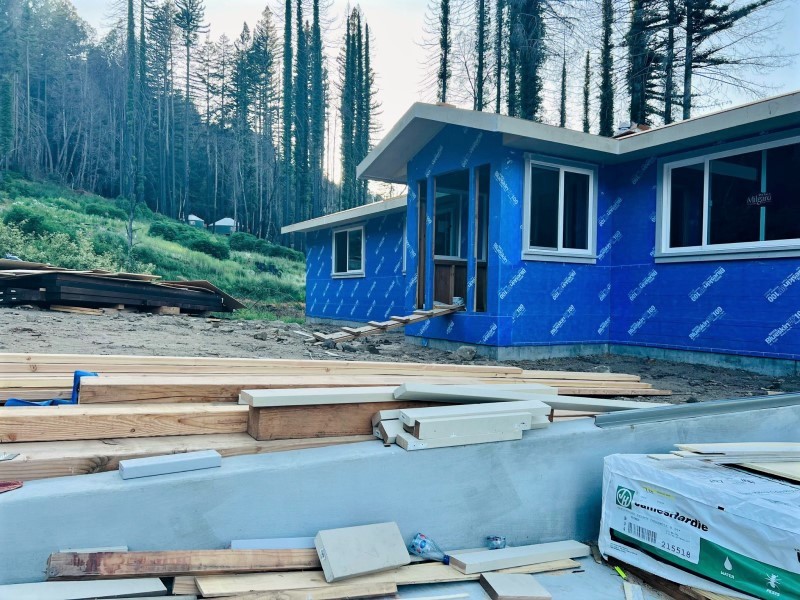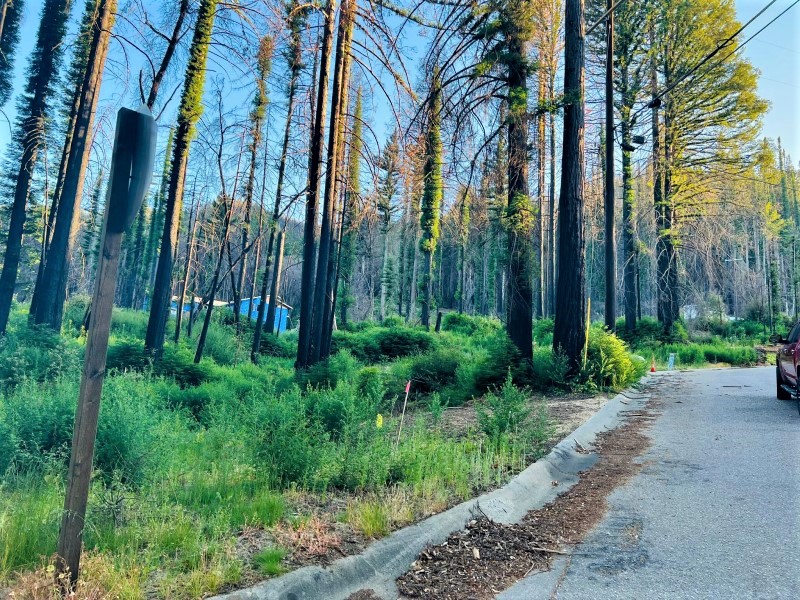Fire Sprinkler Code is the New Geology for Fire Victims
By Antonia Bradford
It is no secret that the path to recovery for the fire families of the 2020 CZU Lightning Complex event has been difficult, expensive, and painful. The battles with the County of Santa Cruz regarding geology and septic have been well documented in the press with Board of Supervisors meetings packed and intense with public outcry. Through those battles fire victims spoke up, begging to not be burdened with prohibitive codes that would make rebuilding impossible for many. The community asked that county officials live up to their word after the fire and not treat fire victims as new builds but as replacements. And because of the pushing, compromises were made on both sides, and property owners were allowed to move forward without costly geology assessments.

Fire code is the new geology
Under the county’s fire code today, all new construction must include fire sprinklers in the home and provide a minimum water pressure before being signed off by fire officials. These sprinklers are not meant to save the home from a wildfire. Rather, they are a notification method so that the occupants can get to safety and suppress an early-stage fire in adequate time. No one questions the importance of these systems in homes. However, the requirement as described today creates an obstacle to rebuilding in areas where San Lorenzo Valley Water District (SLVWD) and Big Basin Water (BBW) experienced fire damage that impacts water pressure. This requirement treats the CZU fire rebuilds as new builds, which county officials promised would not happen.
For those on well systems, the water pressure requirement isn’t a large issue as tanks and pumps would already be a part of their rebuild costs. However, SLVWD and BBW have been unable to tend to repairs that would bring parts of their system in the burn zone up to requisite water pressure.

Fire sprinkler pipes are much larger than the main line that feeds a home. So in order to deliver water when needed a much larger amount of pressure and volume is required. Fire families are discovering that the two local water companies just cannot satisfy the pressure and volume requirements which are determined by the state. And the answer to this dilemma seems to be to require fire victims to shoulder the burden of the water companies not meeting state code. With the majority of fire victims underinsured and of moderate means, and in a construction climate where bids of $600 per square foot are the norm, this additional requirement and the price tag that comes with it could be the nail in the coffin for people on the edge as far as their budget for rebuilding.
While the code originates at the state level, the state defers to the local fire jurisdiction and county to make the final call on whether or not to enforce these rules where there has been a natural disaster. In fact, Chief Mark Bingham of the Boulder Creek Volunteer Fire Department has offered fire-related road variances to CZU fire victims as was confirmed during Supervisor Bruce McPherson’s April 18 community meeting at the Boulder Creek fire station. However, currently Bingham is choosing not to offer a water pressure variance. Dave Reid, director of the County’s Recovery Permit Center (RPC) said that while many had thought fire code would be the biggest hurdle for fire victims during the pre-clearance phase, it had actually been the lowest chokepoint except for those in the Last Chance neighborhood. Now with Bingham’s stance – asserting that the fire sprinkler water pressure issue is one aspect of the code that he is aggressively unwilling to waiver on – the chokepoint is at final inspection. No compromises are to be made, fire families need to comply. But when a family who has lost everything is made to shoulder this burden because local water companies are not meeting the state standard for water pressure, the unfairness of this requirement stands out. We question why our local fire agencies and elected officials aren’t coming up with compromises as has been accomplished in other disaster areas such as Siskiyou County.
Seeing the sprinkler issue as the chokepoint that it is, the County’s ad hoc Long Term Recovery Group has been researching ways to satisfy the code with alternative solutions. One idea is to purchase tanks and pumps that could be lent to a neighborhood. These would be communal tanks set in place until SVLWD and BBW are able to satisfy water pressure requirements. It is unclear how this option would work in a neighborhood that is spread out over mountainous terrain with varying stages of permitting and building progress amongst fire families.
Another solution that has been proposed is residential pump tank packages. These small closet sized systems provide the pressure needed should the fire sprinkler engage at an individual home level. This would be an excellent solution it seems, especially if the Long Term Recovery Group uses the millions of dollars donated for fire victims to foot the bill. Concerns have been raised, however. These units are very difficult to come by and it is understood that the majority of fire protection techs lack the training or experience to install them. Lastly, the timing to implement this plan with these closet systems may fall short for many fire victims to satisfy the requirements during the final inspection of the rebuilt home.
For many, due to the many lengthy County delays, loss-of-use insurance is running out. This is the part of insurance that pays for rentals while the replacement house is being rebuilt. This is not an endless bucket of money, and once it’s gone, it’s gone. The County issues that delayed so many fire families, including the recent geology fiasco, have them racing to the finish to complete their rebuilds before rental insurance is totally depleted. Precarious situation for those who have already suffered so much.
Fire families unable to pass final inspection
If the local fire official determines that sufficient water pressure is unable to be supplied at a predetermined minimum, then the home would not pass final inspection and occupancy would be illegal. Many families would then have to decide whether to find a way to continue to pay rent and mortgage at the same time, live in their rebuilt homes illegally, or face homelessness.
Julie Lucia is one of those people. Her home in the Fallen Leaf neighborhood of Boulder Creek was lost on August 20, 2020 in the CZU Fire. Between fighting the county over geology and her insurance company, Nationwide, her family’s path to recovery has been rough and rocky. But after finally passing pre-clearance and obtaining permits the Lucia family and their general contractor wasted no time in breaking ground. With their insurance money for rent rapidly running out, they need their rebuilt home to be ready as soon as possible. Like any other family they can not afford to pay both rent and mortgage, it has to be one or the other.
“I was in tears about this last night. Our lease is up in June and our landlord only likes six-month leases so we have to fight to get our rent paid past September” said Lucia. “They make us prove that we aren’t the ones holding up the process and even though I provide them with a detailed timeline and emails from the county they have zero empathy.”
Lucia has progressed in her build enough that a fire sprinkler technician came out to test their water pressure. Her water provider is Big Basin Water. “At first it was great and he said no problem here. But that quickly changed. The water suddenly sputtered out and became a trickle. We are now having to look at tanks and pumps. This is so frustrating. This is the one thing that could keep us from being able to move into our new home. We could end up homeless due to our rental insurance being canceled. If their position is human safety then is forcing a family with young children out onto the streets safe?”

During the April meeting at the fire station, a provisional final inspection approval was suggested. With this idea, fire families install all the plumbing and do everything they are supposed to up to the street. They are then granted provisional final inspection approval with the express understanding that the local water companies will be updating their systems to meet the pressure and code requirements of the state. It currently is not known whether or not the county and fire officials are willing to make this compromise.
Where There’s a Will, There’s a Way
After the devastating Slater Fire, the Siskiyou County Board of Supervisors enacted Ordinance 21-01, an urgency notice amending their regulations for limited density owner-built rural dwellings. Their findings and justification included a progressive understanding of the “unprecedented financial burden” upon the fire victims. And that the health, welfare, and safety of those residents required action. That water, septic, and utility connections were compromised, and that the normal permitting process would “create an unreasonable burden to the property owner to comply with the prescriptive building and development requirements of the current California Building Standards Code.” Siskiyou County officials waived fees and provided for variances that allowed an actual streamlined building process for fire families.
In January 2016, CalFire and the California State Fire Marshall issued Information Bulletin 16-001 Rebuilding After a Wildfire. That document was created to “establish minimum standards for the protection of life and property.” In terms of residential fire sprinkler requirements, while the bulletin recommends installation of a fire sprinkler system, “the final decision to require the installation of fire sprinklers in one-and two-family dwellings rebuilt (after a disaster) is determined by the local building and fire officials.” The document confirms that the fire sprinkler requirement pertains to new builds. After the CZU Fire, Santa Cruz County officials assured local fire victims that their homes would be considered replacements, not new builds. But just like the geology requirements that were being required of fire families, this sprinkler requirement treats fire victims like exactly that: new builds.
In other words, where there’s a will, there’s a way. Siskiyou County had the will and found a way to support fire victims in their rebuilding efforts. They understood that getting those families back on their land in their newly rebuilt homes was the safest and most humane option. This is a clear example of the fire community being supported during some of the most difficult times in their lives.
Murky information from the county
According to county officials, it is the authority of the local fire agencies to enforce the fire code with enforcement by the RPC (county). Should the fire families who run into issues with proper water pressure wish to explore alternative means and methods of adhering to the fire code requirements it would be at the discretion of the local fire jurisdiction to approve such methods. And while it is state code, the local jurisdiction adopts that code, and then it is enforced by local fire agencies. It stands to reason that a compromise could be made if the county and local fire officials were willing to support fire victims in this way. Unfortunately, answers vary from local officials about who is making the final call: fire officials or the county. Whoever is in charge, a waiver is a viable option. Just as there was a workaround for geology, there should be a workaround for this.
Solutions
As in other counties, Santa Cruz County building and fire officials can adopt a provisional fire inspection approval given with the express understanding that the water companies are to be updating their systems to meet state code requirements. This allows the home building process to proceed and complete while SLVWD and BBW comply with the state. A local contractor said, “It’s completely reasonable that the concession that homeowners are making is to install the fire systems knowing that until the water system is fixed, it will not be fully functional. The local building and fire officials should sign off on the home’s final hold. The tradeoff is that the homeowner can get a final and occupy the home and the county has the understanding that the fire system is installed and the water infrastructure will subsequently be upgraded.”
It is not the fault of fire victims that the water districts have been unable to complete their repairs. A variance was created for geology. A variance can be created for water pressure since that will presumably be resolved by the water districts in the hopefully near future. Additionally, if there is widespread support in the fire fighting community that was consistent for all jurisdictions and fire victims no matter the fire official in charge, for the residential pump tank packages, it seems reasonable that the LTRG pay for those systems for each family with the money that has been donated for fire victims of the CZU fire. After all, that’s what that money is for – to support the healing and recovery of those in our community who have lost everything.
FIre Officials Community Meeting
There will be a zoom meeting with fire officials, both Cal Fire and local fire departments, on Monday, May 23rd to cover updated fire recovery regulations including fire sprinkler requirements. The entire community is encouraged to attend and ask questions, even if you didn’t lose your house. The victims of the CZU fire are the guinea pigs of disaster recovery for Santa Cruz County. While it’s clear that this has been a learning process for the county, there are many ways that fire families could have been, and should be, more fully supported. The next time something like this happens, and there will be a next time, the county should understand that the community stands in solidarity with those who are suffering. Easing this fire sprinkler requirement with compromise and solutions is a great way to ease the burden of this arduous journey for fire victims.
CZU Rebuild Community Meeting
Monday, May 23 at 6:00 pm via Zoom
https://us02web.zoom.us/j/81656692518
Antonia Bradford lives in Boulder Creek with her husband and five children. She is a writer, artist, and business owner. She is an advocate for fire families in the area having lost her own home in Boulder Creek as well. She is committed to making contributions to the San Lorenzo Valley community wherever and however she can.
Photos by Antonia Bradford
The San Lorenzo Valley Post is your essential guide to life in the Santa Cruz Mountains. We're dedicated to delivering the latest news, events, and stories that matter to our community. From local government to schools, from environmental issues to the arts, we're committed to providing comprehensive and unbiased coverage. We believe in the power of community journalism and strive to be a platform for diverse voices.






The landlord who is wanting a 6 month lease should compromise and help the fire victim out by allowing them to rent month to month. With the rental market so tight the landlord should easily be able to get new tenants as soon as the property becomes available.